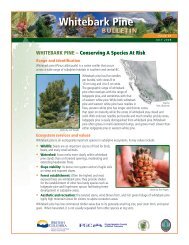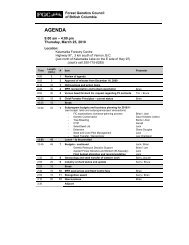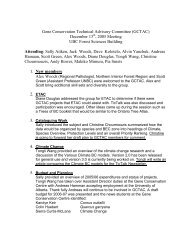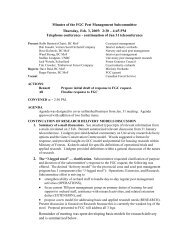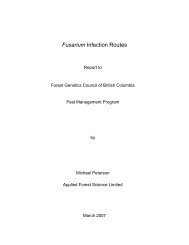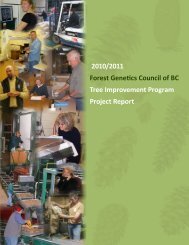Tree Improvement Program Project Report 2006 / 2007
Tree Improvement Program Project Report 2006 / 2007
Tree Improvement Program Project Report 2006 / 2007
You also want an ePaper? Increase the reach of your titles
YUMPU automatically turns print PDFs into web optimized ePapers that Google loves.
. True F r Forest Genet cs<br />
Charl e Cartwr ght<br />
Because of their limited value as solid wood products,<br />
true firs are mainly planted to meet green-up and<br />
diversity concerns. Nevertheless, gains due to seed source<br />
(provenance) of between 5 and 10 percent are available<br />
for several species. To date, plans for taking advantage of<br />
these potentially more vigorous sources of seed are still in<br />
development.<br />
Pac fic s lver fir – SPU 09<br />
Two new Pacific silver fir provenance test sites were<br />
established in <strong>2006</strong> to cover the use of the species in the<br />
regeneration of blocks in the mountain hemlock (Hm)<br />
BECs. As well, 12 test sites planted between 2002 and<br />
2003 were maintained. Eight of these were subsequently<br />
measured. We hope to report results from these trials in<br />
the next fiscal year. We sent seed from our provenance<br />
collection to Dr. Ulrick Nielsen of the Danish Centre<br />
for Forests, Landscape, and Planning for use in their<br />
provenance tests.<br />
Sub-alp ne fir<br />
Two new sub-alpine fir provenance test sites were<br />
established in <strong>2006</strong>, one to look at more extreme conditions<br />
than current installations, and the other to provide material<br />
in an appropriate environment that is also accessible for<br />
a larger part of the year. We reported results derived from<br />
data taken the previous year to the annual meeting of the<br />
Western Forest Geneticist Association in Anchorage in June<br />
<strong>2006</strong>. Seed was collected in the American West in the fall<br />
of <strong>2006</strong> to take advantage of good cone crops. The current<br />
seed inventory covers BC and adjacent Alberta, Yukon, and<br />
Washington State, but no provenances between 33 and 48<br />
degrees North are held, although the species is common at<br />
appropriate elevations in these latitudes.<br />
T R E E I M P R O V E M E N T P R O G R A M<br />
P R O J E C T R E P O R T 2 0 0 6 / 2 0 0 7<br />
. Western Redcedar Breed ng<br />
<strong>Program</strong><br />
John Russell, Cra g Ferguson<br />
There are 930 parents established in first-generation<br />
polycross tests for the maritime low SPU. Seven annual<br />
series of tests were planted on 46 sites over six SPUs.<br />
Breeding values for volume at rotation are currently<br />
available for 555 parents from series 1 based on 10-year<br />
heights, series 2-4 on seven-year heights and series 5 on<br />
five-year heights. Approximately 75 parents from the first<br />
five series have been selected for advanced generation based<br />
on height and established into breeding orchards. Breeding<br />
for second-generation tests is ongoing.<br />
Full-sib and self families from deer-browse-resistant<br />
selections (high-needle monoterpene concentration) are<br />
currently being established into field trials and further<br />
within-family selections for browse resistance and needle<br />
monoterpene concentrations are ongoing.<br />
.6 Yellow-cedar Breed ng<br />
<strong>Program</strong><br />
John Russell, Cra g Ferguson<br />
There are currently clonal values from approximately<br />
5,000 clones represented in three series of annual testing<br />
based on nine-year data from the first and second series<br />
of cloned progeny tests, and six-year data from the third<br />
series. These new clonal selections have been repropagated<br />
for operational release. Maintenance continued this<br />
year in both field trials and breeding orchards, as well as<br />
monitoring of pollen performance and production for<br />
collection for advanced-generation breeding.<br />
Various technical support projects were maintained<br />
and measured. These include clonal maturation, clonal<br />
competition, pollen viability, and deer-resistance studies.<br />
Fifteen-year data have been collected from both the first<br />
and second series of provenance trials.<br />
11



